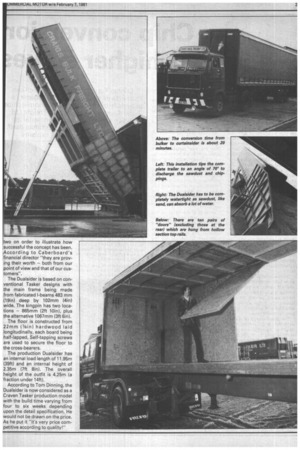Chip conversio means higher stake
Page 28

Page 29

If you've noticed an error in this article please click here to report it so we can fix it.
WHEN IS a bulker not a bulker? When it can double up as a curtainsider is the answer to that as far as Craven Tasker is concerned.
The Cumbernauld factory has produced the Dualsider — a trailer which can be used for carrying bulk loads or palletised goods so the operator should never be stuck for a return load.
The prototype of the device went into service with Craig's Bulk Freight Ltd with the concept coming about as a result of Jim Craig's discussions with Craven Tasker. Because of the nature of one particular operation, he couldn't get a return load which, as every accountant knows, is an expensive way to run a business.
Craig's Bulk Freight Ltd has a contract from Caberboard of Cowrie in Stirlingsh ire who manufacture high-quality chipboard for use in the furniture industry. The Craig operation involves transporting the raw material — be it as sawdust, shavings or chips — in bulk to the Caberboard factory and the delivery of the finished goods to a distribution point in Manchester.
The Dualsider was designed to allow both operations to be carried out using the same basic vehicle. It is built so that the side doors swing up into the roof, leaving the entire sideloading area free with no pillars to obstruct the forklift truck.
The disadvantage of this arrangement is that it restricts the height of the cargo area to the same dimension as the trailer width, but for most types of work this should not be a serious problem — it certainly isn't for the Craig/Caberboard operation.
The two longitudinal hollow section beams had to be manufactured in such a way that when all the doors were fitted they would close without any spillage of the raw material.
There are in fact ten pairs of doors (excluding those at the rear) which are hung from these hollow section top rails. A hightensile steel locking pin secures each door in the vertical position and when all are in place the operator can fill the "bulk" body by gravity hopper or by blowing the material in.
To enable the trailer to be used as a curtainsider, the doors are swung up to the horizontal position and secured in the hollow section roof using the same set of locking pins.
With the doors up in the roof, the trailer presents a completely open aspect for side loading. With the side curtain then in position, they are tensioned using the Tasker ratchet and lever system.
The door frames are in aluminium alloy, panelled with ten millimetre (0.4in) boarding. This is similar to chipboard but coated for exterior use. The multiple side doors and those at the rear are all of the same construction.
Because of the nature of this particular bulk load — sawdust, like sand, can absorb a lot of water, and hence weight — the structure has to be completely watertight. To achieve this, the doors overlap at 'each joint and thus must be opened and closed in the right sequence.
In practice, the Craig drivers have found that 20 minutes is an average "conversion" time from bulker to curtainsider. When the Dualsider in bulk form arrives at the Caberboar factory it is backed in to a perm nent tipping installation whic tips the complete trailer up to a angle of 70° to discharge th sawdust, chips and so fortl through the rear doors.
The average time from drive i to drive out is around 20 mir utes, with the limiting factor bE ing the ability of the un derground screw to carry th load away.
The sides are then swung u into the roof and secured, whil all that remains is to haul th trailer into the factory to be sidE loaded with finished chipboar — about 20 tons of it.
The prototype Dualsider, bui specifically for Craig's Bul Freight Ltd to try out th concept, was deliberately "ove engineered" according Crave Tasker's director and managE Tom Dinning.
After endurance testinc Tasker found out which par could be made lighter withot weakening the structure. ThE the weight came down — froi just over seven tonnes to 6 tonnes (6 tons 2 cwt).
Craig's now have six Dualsii ers in operation and a furthi
two on order to illustrate how ,successful the concept has been. Accordin.g to Caberboard's financial director "they are proving their worth — both from our point of view and that of our customers".
The Dualsider is based on conventional Tasker designs with the main frame being made from fabricated I-beams 483 mm {19in} deep by 102mm (4in) wide. The kingpin has two locations — 865mm (2ft 10in), plus the alternative 1067mm (3ft 6in).
The floor is constructed from 22mm (7/am) hardwood laid longitudinally, each board being half-lapped. Self-tapping screws are used to secure the floor to the cross-bearers,
The production Dualsider has an internal load length of 11.95m (39ft) and an internal height of 2.35m (7ft 81n). The overall height of the outfit is 4.25m (a fraction under 14f1).
According to Tom Dinning, the Dualsider is now considered as a Craven Tasker production model with the build time varying from four to six weeks depending upon the detail specification. He would not be drawn on the price. As he put it "it's very price competitive according to quality!"












































































































